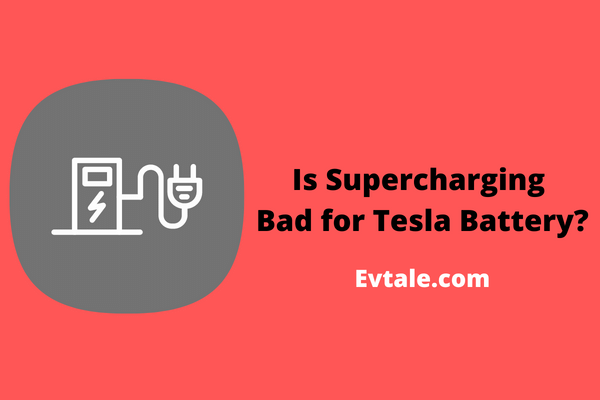Yes, constantly supercharging your car is bad for the battery. However, the effect is so slight that some individuals might not perceive it.
Furthermore, the peak-charging pace of a battery may also drop if you regularly power your Tesla using superchargers. It will thus reduce the effectiveness of the battery.
To do a non-tesla DC quick charge, like at Chademo stations, will harm your batteries further. You’ll notice Tesla restricting your supercharging pace if you often power your EV together at non-Tesla DC rapid stations many times each week.
Tesla Supercharger disadvantages
While Supercharging your EV, Tesla has highly advanced battery management mechanisms, so there’s virtually nothing you could do to harm the batteries.
The worst-case scenario would be to reduce the optimum charging to where the Model S would be now. However, there can be other drawbacks one needs to keep in mind before supercharging their automobile. So, here are some heads up for you.

- You will begin to observe Tesla restricting your charger rate if you often recharge the Tesla at any one station.
- Additionally, compared to charging at home, supercharging costs around double more per kWh of electricity.
- Charger speed is also slowed by cold conditions. This won’t be a problem for overnight recharging. However, it could cause a small delay when traveling.
- The projected range often declines during the initial several months until leveling out.
- Mileage on full load may gradually but naturally reduce with time; how much of a drop varies on the device’s age or mileage, how frequently it is supercharged, and other variables.
- Using a Supercharger, it’d take about 75 mins to fully charge the vehicle.
- Even though Superchargers are quicker than other types of electric car chargers, they still take longer than loading the tank with gasoline. Therefore, it’s crucial to provide additional time for recharging while planning your vacations.
- Destination Chargers are really not usually available in the exact same practical places. This is due to the fact that Tesla’s Charging Associates are spread throughout the country, not only in big towns or on busy routes.
- Despite being made with your ease in consideration, the built-in Ev charging point map has certain issues.
- When it comes to system upgrades, many Vehicle owners have complained that the navigation software has problems.
- Others have noticed that the equipment occasionally has to be restarted to function properly.
- Overcharging your Tesla at Superchargers might really damage the vehicle.
- When used too frequently, the powerful charger strains your Tesla’s batteries, shortening its lifespan.
- With the acquisition of one of its vehicles, Tesla no more provides free Supercharging.
- At several Supercharger locations that the EV manufacturer claims are in a growing market, Tesla users charging at such locations believe their charger restrictions have been adjusted to 80%.
How do you precondition a Tesla battery for Supercharging
Wouldn’t want to charge for longer than is required?
If that’s so, it’s appropriate to take preconditioning into account.
Your electric car will run more effectively and require less time to recharge if your battery has been preconditioned.
There are several ways to prepare your vehicle’s energy for recharging when you’re among the many newbies or seasoned users who might not know what to do. Read along to learn more.

1. Precondition by using the navigation feature
Before supercharging, activate the navigation function.
Just use your screen’s navigation to find a Supercharging connection. The preconditioning of the batteries will begin immediately in the car.
2. Preconditioning Scheduled Departure Function
Utilize your Scheduled Departure option to program your automobile to leave on time. Use the touchscreen’s “Planned Departure” option to specify your subsequent scheduled departure.
To establish a time spent when you wish to be prepared to drive, click the Temperature Controls options page, switch on preconditioning within settings, and then select “Schedule” Your Tesla will calculate how much your vehicle needs to warm up, so it is ready to go at the scheduled time.
3. Drag Strips Mode conditioning
Drag Strips Mode is a function of the Tesla Model S. In front of a sprint race, preconditioning the Model S with Drag Strips Mode is helpful.
Drag Strips Mode prepares the batteries and motor unit for scheduled acceleration by preheating them to optimal operating conditions.
If you quit your Model S, it remains in Drag Strips Drive for 3 hours. To avoid irrational energy use, the functionality goes out after 3 hours.
How to precondition Tesla battery from the app
Utilize the application’s climate settings. You may preheat the vehicle by turning the “preconditioning” and “defrost” upon that application.
On the highway, this will significantly conserve energy. We advise plugging your automobile in as its preconditions.
For pre-conditioning:
Access the application, then select “Climate” > “Switch On.”
For defrosting:
Access the application, choose “Climate,” then keep scrolling and choose the “defrost” option.
Additionally, you may prepare your battery using the Scheduled Exit option around the application.
Then choose “Schedule.”
Decide on a time to go.
Switch on the “Precondition” option.
The vehicle will warm the batteries and adjust the thermostat to the very last setting user selected.
Is Slow Charging Bad for Tesla? [Let’s See]
Summing up
The ability to save money on petrol is an EV’s main selling feature, yet when making a purchasing decision, EV owners are more worried about recharging and ranging anxiety.
However, if you utilize the Supercharger, the integrated computers would keep hold of your batteries.
There has been a lot of discussion about managing your Tesla power pack carefully. Over the course of their lifespan, all packs will experience some deterioration, but most users won’t even notice it because the proportion of degradation brought on by supercharging is little.
Follow Tesla’s advice to the greatest extent you can. Charge mostly at home, if that’s not possible, utilize a Supercharger instead.